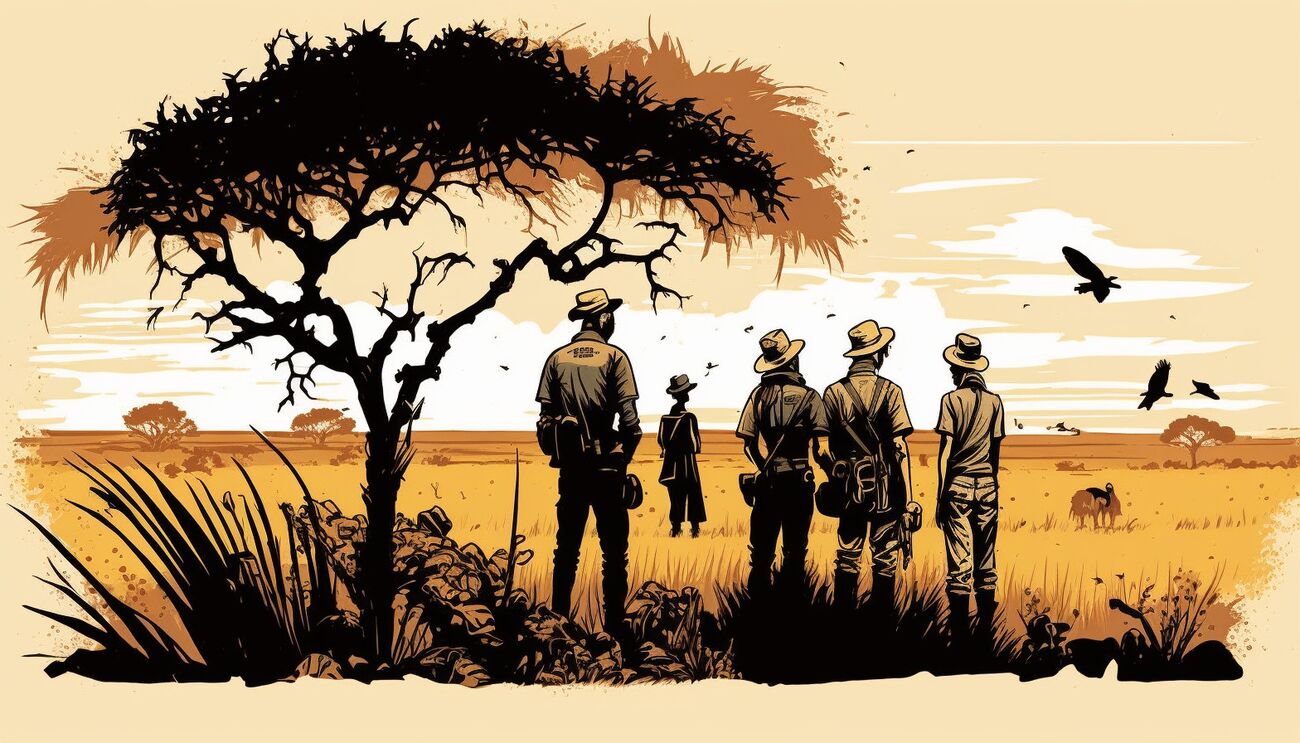
Wings Over South Africa: 10 Must-See Birds for International Birders
South Africa is a birdwatcher's paradise, with a diverse range of bird species that can be found throughout the country. From the stunning African Penguin to the majestic African Fish Eagle, there is no shortage of beautiful birds to see in South Africa.
For international birders looking to explore the country's avian wonders, there are certain "must-see" birds that should be at the top of their list. In this post, we'll be taking a closer look at 10 of the most popular South African birds that international birders will not want to miss. So grab your binoculars and get ready for an unforgettable birdwatching adventure in South Africa!
African Penguin

African Penguin - Photo Credit: Wikimedia Commons
The African Penguin is a unique and charming bird species that's found along the South African coastline. These penguins are known for their distinctive black and white plumage, with a black stripe across their chest and a black horseshoe-shaped band around their neck. They also have pink patches of skin around their eyes, which become more vibrant during breeding season.
The African Penguin is endemic to southern Africa and is listed as an endangered species, with only a few thousand individuals remaining in the wild. They typically live in large colonies on rocky islands or along the mainland coast, where they feed on small fish like anchovies and sardines.
For international birders visiting South Africa, the African Penguin is a must-see species. These penguins are unique to the southern African coastline and offer a fascinating glimpse into the marine birdlife of the region. Visitors can typically see African Penguins at several locations, including Boulders Beach in Simon's Town, Stony Point Nature Reserve near Betty's Bay, and Robben Island near Cape Town. In addition to their distinctive appearance, African Penguins are also known for their interesting social behavior and vocalizations, making them a favorite among birders and wildlife enthusiasts.
African Fish Eagle

African Fish Eagle
The African Fish Eagle is an iconic bird of prey that's bound to captivate any international birder visiting South Africa. With its distinctive brown body, white head, and powerful hooked beak, the eagle is a symbol of the country's wilderness and natural beauty. Found near waterways and lakes, the African Fish Eagle is an exceptional hunter, and a sighting of it swooping down to snatch a fish from the water is a thrilling experience.
However, what truly sets this bird apart is its unmistakable call, which is often described as the quintessential sound of the African wilderness. The call, a distinctive and hauntingly beautiful cry that is often heard echoing across rivers and lakes, is just one reason why the African Fish Eagle is a must-see bird for any international birder visiting South Africa.
Additionally, the African Fish Eagle's ecological importance as a top predator and its cultural significance in many African societies make it a fascinating species to learn about and observe in its natural habitat. This bird has made such an impression that it is the national bird of 4 African countries (Namibia, Zimbabwe, Zambia and Sudan).
For any birdwatcher on a limited time in South Africa, an encounter with the African Fish Eagle is a must-see experience that's sure to leave a lasting impression.
Cape Sugarbird
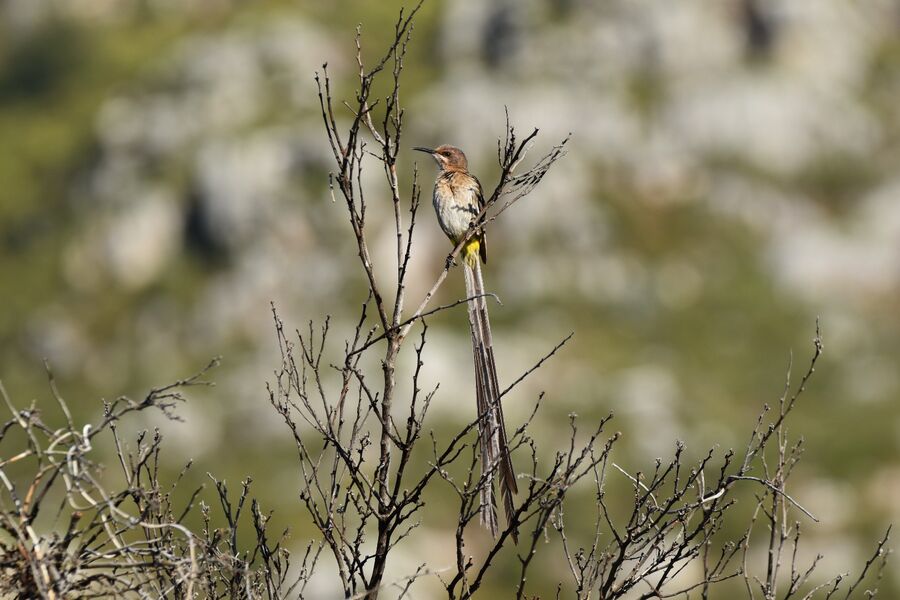
Cape Sugarbird
The Cape Sugarbird is an endemic bird species found in the fynbos biome of South Africa. These birds are known for their long, curved bills, elongated tail feathers, and striking plumage, with a mix of brown, yellow, and white feathers and a bright red breast patch. They feed on nectar from protea and erica flowers and are also known for their acrobatic flight displays.
The Cape Sugarbird should not be missed if you are visiting the shores of Sunny South Africa. Not only is the Cape Sugarbird endemic to South Africa, but the whole Sugarbird family is endemic to South Africa - they cannot be found in any other country worldwide. They offer a unique glimpse into the avian diversity of the fynbos biome and are unlike any other bird species in the world. Their striking plumage and acrobatic flight displays are also a highlight for birdwatchers and nature enthusiasts.
The Cape Sugarbird can be found in areas like the Kirstenbosch National Botanical Garden or the Cape of Good Hope Nature Reserve, where they can be observed feeding on nectar and displaying their aerial acrobatics. Early morning or late afternoon tend to be the best times to observe these birds. Visitors can also try visiting fynbos habitats in the Western and Eastern Cape provinces, where they may spot these beautiful birds in the wild.
In addition to their striking appearance and behavior, Cape Sugarbirds play an important role in their ecosystem as pollinators of fynbos plants. They are also culturally significant for some indigenous communities in South Africa, who have traditional beliefs and practices associated with the bird. Observing a Cape Sugarbird can provide more than just a view of the diverse birdlife in the area; it can also provide a window into the intricate ecological and cultural connections present in South Africa.
Blue Crane
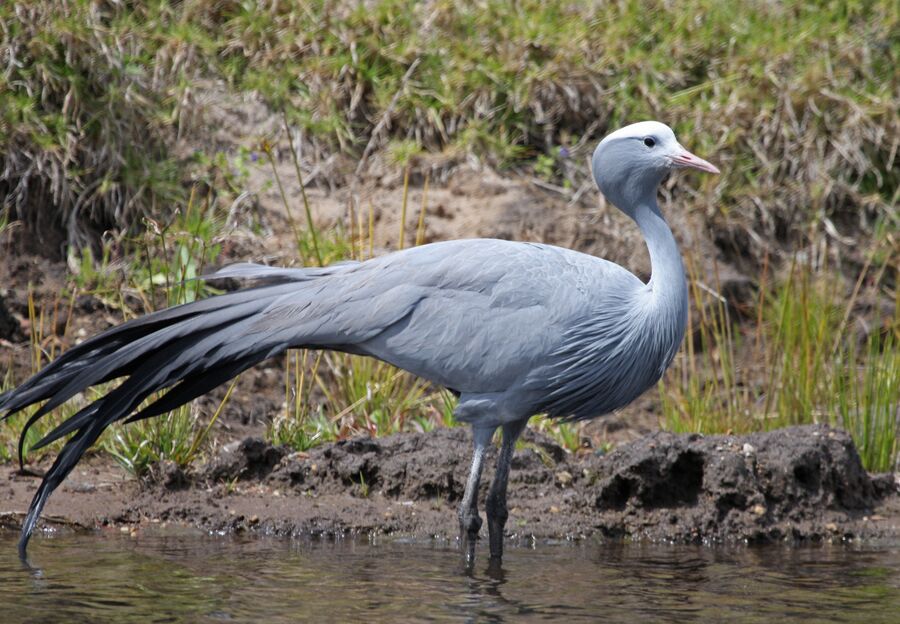
South Africa's National Bird - the Blue Crane - Photo Credit: Wikimedia Commons
The Blue Crane is a striking bird that is endemic to Southern Africa. It is the national bird of South Africa and is featured on the country's five rand coin, making it a symbol of national pride and cultural significance.
One of the most distinctive features of the Blue Crane is its elaborate courtship dance, which involves the birds leaping, bowing, and flapping their wings while calling out in a high-pitched tone. This display is not just a spectacle for birdwatchers; it is also a key part of the bird's social behavior and mating rituals.
The Blue Crane is also ecologically important as a natural pest controller, preying on insects and rodents that can damage crops. However, the bird's population has been in decline due to habitat loss and human disturbance, making it a species of conservation concern.
For international birders, spotting the Blue Crane in its natural habitat is a rare and rewarding experience. They can typically be found in open grasslands and agricultural fields in South Africa - A famous place for seeing them is the revered Wakkerstroom. Seeing these majestic birds up close offers not just insight into the region's rich birdlife, but also a deeper understanding of the cultural and ecological significance of this iconic species.
Knysna Turaco
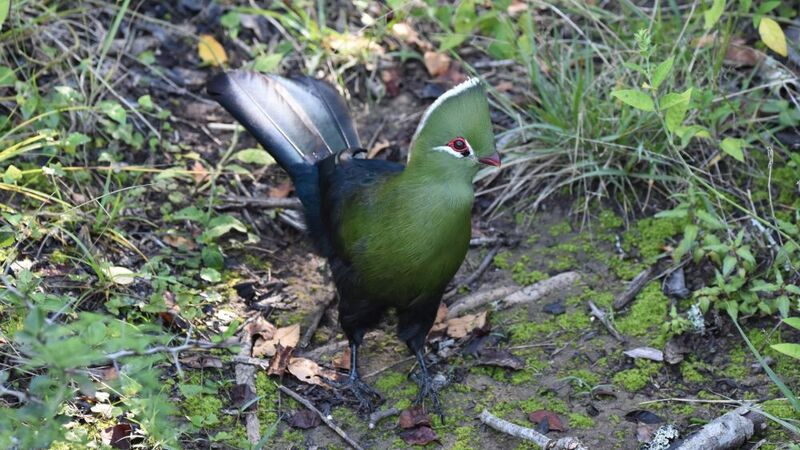
Knysna Turaco
The Knysna Turaco is a colorful and charismatic bird species that's found in the forests of southern Africa. These birds are known for their distinctive bright green plumage, with a majestic crest and striking features. They also have a unique, growling call that's often heard in the forest canopy.
The Knysna Turaco is endemic to southern Africa and can be found in the coastal forests of South Africa and Eswatini. They typically live in pairs and feed mainly on fruits, and occasionally insects.
For international birders visiting South Africa, the Knysna Turaco is a must-see species. These birds are unique to the coastal forests of southern Africa give birders a preview of the fascinating birdlife that live in them. Visitors can typically see Knysna Turacos in forested areas like the Knysna and Tsitsikamma forests, where they can observe their colorful plumage and hear their unique calls.
In addition to their striking appearance, Knysna Turacos are also known for their interesting social behavior, including their displays of courtship and territorial defense. For any international birder visiting South Africa, the Knysna Turaco is an enchanting and captivating bird that should not be missed
Cape Vulture

Cape Vulture in Flight
The Cape Vulture is a large, distinctive vulture that is endemic to Southern Africa, making it a special bird to see for international birders. With its wingspan of up to 2.6 meters, it is one of the largest birds of prey in the region.
Cape Vultures can typically be found in mountainous regions of South Africa, Lesotho, and Eswatini. They are known for their scavenging behavior, feeding on the carcasses of large mammals such as antelopes, wildebeest, and zebras. However, they are also known to hunt small animals, such as rodents and reptiles.
One of the unique features of the Cape Vulture is its bald head and neck, which are adapted to prevent feathers from becoming soiled while feeding on carcasses. This, along with its long, pointed beak and keen eyesight, make it an efficient scavenger.
Unfortunately, Cape Vultures are also an endangered species due to habitat loss, poisoning, and electrocution from power lines. Conservation efforts are ongoing to protect and restore their populations.
For international birders, seeing a Cape Vulture in the wild offers a chance to witness one of Southern Africa's most impressive birds of prey. It also provides an opportunity to learn about the challenges facing this species and the importance of conservation efforts.
Cape Vultures also hold cultural significance for some indigenous communities in Southern Africa. For example, in some areas of South Africa, the birds are considered to be a symbol of death and are associated with ancestral spirits.
Southern Ground Hornbill

Southern Ground Hornbill
The Southern Ground Hornbill is a large and striking bird that is endemic to Southern Africa, making it a highly sought-after sighting for international birders. With its deep booming call, large size, and striking black and red plumage, the Southern Ground Hornbill is a unique and impressive species.
These birds can typically be found in savannas and grasslands across Southern Africa, from South Africa to Tanzania. They are known for their ground-dwelling behavior, as they forage for food on the ground, and for their strong family bonds. Southern Ground Hornbills are also highly social, with groups consisting of a breeding pair and several helpers, often their offspring from previous years.
One of the most interesting aspects of the Southern Ground Hornbill is its role as a keystone species in the ecosystem. As they forage on the ground, they play a crucial role in controlling populations of rodents and other small animals. Additionally, their large size and strong beaks allow them to break open tough nuts and seeds, contributing to the dispersal of these plant species.
Unfortunately, the Southern Ground Hornbill is also listed as vulnerable due to habitat loss and hunting. Conservation efforts are ongoing to protect and restore their populations.
Southern Ground Hornbills also hold cultural significance for some indigenous communities in Southern Africa. In some areas, the birds are considered to be symbols of good luck and are associated with traditional healing practices, and they are traditionally known as the "Thunderbird" as they are believed be a harbinger of rain.
For international birders, seeing a Southern Ground Hornbill in the wild is a true highlight of any trip to Southern Africa. The birds' size and unique appearance make them an unforgettable sight, and their cultural significance adds to their appeal.
Secretarybird
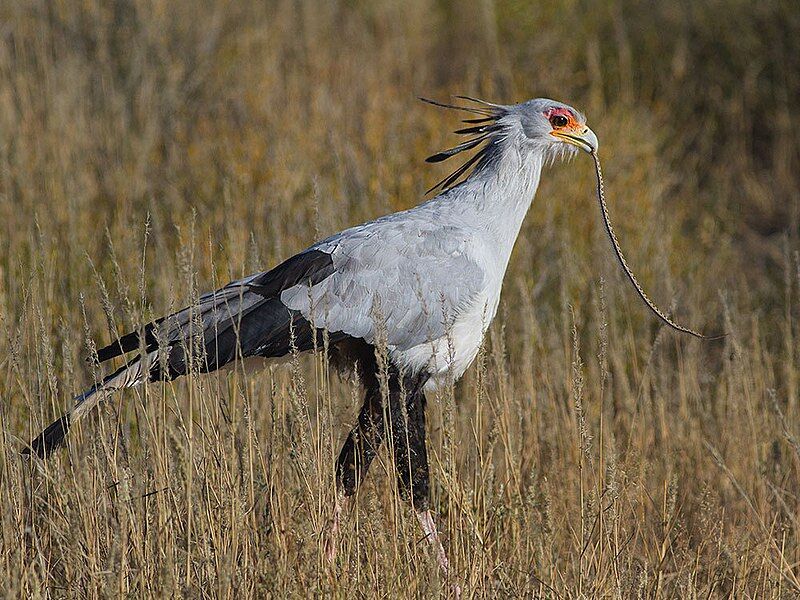
Secretarybird - Photo Credit: Wikimedia Commons
The Secretarybird (Sagittarius serpentarius) is a large bird of prey that is native to the savannahs and grasslands of Africa, including South Africa. It is known for its striking appearance, with long, black feathers that resemble quill pens behind its head, giving it the appearance of a colonial-era secretary.
Despite its unique appearance, the Secretarybird is a formidable hunter, famous for hunting snakes but also preying on a variety of small animals such as rodents, reptiles, and insects. It is also known for its unique hunting behavior, which involves stomping on prey with its powerful legs to stun or kill them.
In addition to its hunting prowess, the Secretarybird also plays an important ecological role as a natural predator, helping to control the populations of its prey species.
For international birders, spotting the Secretarybird in the wild can be a thrilling experience. They can typically be found in open grasslands and savannahs in South Africa and other parts of Southern Africa. Watching these majestic birds hunt and display their unique behaviors offers a glimpse into the region's diverse and fascinating avian fauna.
Aside from its ecological significance, the Secretarybird also holds cultural significance for some indigenous communities in Southern Africa. For example, in some parts of Zimbabwe, the bird is believed to possess mystical powers and is associated with rainmaking and fertility. Learning about the cultural significance of the Secretarybird can provide a deeper understanding of the complex relationships between people and nature in the region.
Cape Rockjumper
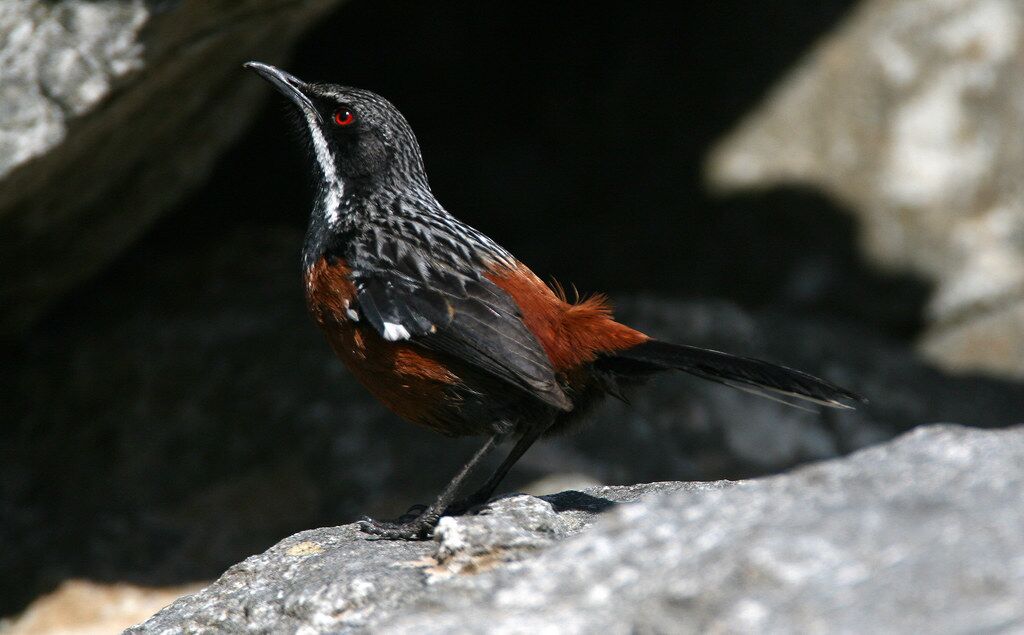
Cape Rockjumper - Photo Credit: Blake Matheson
The Cape Rockjumper, is a small bird species endemic to South Africa. As its name suggests, it can be found hopping and climbing among rocky outcrops and boulder-strewn slopes in the country's southwestern mountains, including the Cederberg and the Cape Peninsula.
This striking bird has a distinctive orange breast and a mottled brown and grey back, which allows it to blend in with its rocky habitat. Its call is a series of clear, ringing notes, which can often be heard before the bird is spotted.
Due to its limited range and specialized habitat requirements, the Cape Rockjumper is considered a range-restricted species and is of high conservation concern. However, for international birders, it presents an opportunity to observe a unique and highly sought-after bird species. Its specialized habitat and limited range make it an excellent example of the incredible diversity and endemism of South Africa's birdlife. In fact, not only is the Cape Rockfumper endemic to South Africa, the entire Rockjumper family (like the Sugarbirds) is endemic to this country.
When visiting South Africa, the Cape Rockjumper can be found in protected areas such as Table Mountain National Park and the Cederberg Wilderness Area, as well as in private reserves and natural areas throughout the Cape Floristic Region. A sighting of this remarkable bird is sure to be a highlight of any birding trip to the region.
Martial Eagle

Martial Eagle
The Martial Eagle is a large and powerful bird of prey found throughout much of sub-Saharan Africa, including South Africa. It is considered the largest eagle in Africa, with a wingspan of up to 2.5 meters and a weight of up to 5 kilograms.
This majestic bird is easily recognized by its dark brown feathers and distinctive crest of feathers on its head. It can often be found perched on high vantage points, such as tall trees or rocky outcrops, scanning the landscape for prey. As an apex predator, the Martial Eagle primarily feeds on other birds and mammals, including small antelope.
The Martial Eagle is an iconic and revered bird species in many African cultures, and its impressive size and strength have earned it the nickname "king of the eagles". Unfortunately, due to habitat loss, hunting, and poisoning, the Martial Eagle is now considered a vulnerable species and is of high conservation concern.
For international birders, the Martial Eagle offers a chance to observe one of Africa's most impressive and powerful birds of prey in its natural habitat. While it can be found in protected areas and reserves throughout South Africa, it is often a rare and elusive sight. Encountering this extraordinary bird is guaranteed to be a standout moment of any birding expedition to the area.
What Are You Waiting For?
South Africa is a bird-watching paradise, offering a diverse range of habitats and a wealth of unique and fascinating bird species. From the regal and powerful Martial Eagle to the colorful and charismatic Knysna Turaco, there's no shortage of must-see birds for international birders visiting the country.
Whether you're an experienced birder or just starting out, South Africa has something to offer everyone. With a rich cultural heritage and stunning natural landscapes, there's no better place to explore the vibrant birdlife of southern Africa.
So pack your binoculars and book your trip to South Africa today – the birding adventure of a lifetime awaits!

The Beautiful Drakensberg
